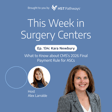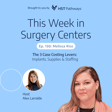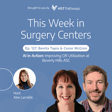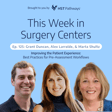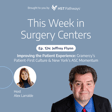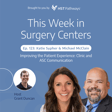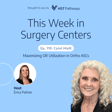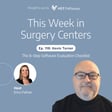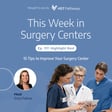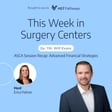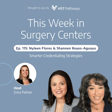Podcast Introduction
00:00:01
Speaker
Welcome to This Week in Surgery Centers. If you're in the ASC industry, then you're in the right place. Every week, we'll start the episode off by sharing an interesting conversation we had with our featured guests, and then we'll close the episode by recapping the latest news impacting surgery centers. We're excited to share with you what we have, so let's get started and see what the industry's been up to.
00:00:27
Speaker
Hi, everyone. Here's what you can expect on today's episode.
Capitalizing on the Cardiology Boom
00:00:31
Speaker
Today is part two of our three part series about how you can capitalize on the cardiology boom. Last week, we talked with Kristen Richards about key considerations before adding CV procedures to your ASC. And today we'll be sitting down with Kristen Truesdale. who is the Senior Vice President at Corazon to cover all things money related. So we'll get into what expenses you'll encounter, how to negotiate with payers, and just general strategies ASCs can leverage to maximize reimbursement on those CV procedures.
News Highlights and Trends
00:01:06
Speaker
In our news recap, we'll cover rapper fat Joe on Capitol Hill trends that are exciting ASC owners right now, the power shift in ASC ownership, and of course, and the new segment with a positive story about a groundbreaking device called Popsie that was recently developed by a nurse. Hope everyone enjoys the episode and here's what's going on this week in surgery centers.
Interview with Kristen Truesdale Begins
00:01:36
Speaker
Kristin, welcome to the show. Thank you. Thank you for having me. So Kristin, excited to talk to you today about cardio and the cardio boom we're seeing in the ASC space. Can you give us a little bit of your background, specifically your experience with cardio? Sure. So my name is Kristin Truesdo. I'm a senior vice president at Corazon. Just a little bit about Corazon. It's a national leader in strategic program development for Cardiacs mainly, but we also do vascular, neuro, spine, and orthopedics and surgical service lines. And whenever I say that, i our team of subject matter experts has worked with all types of not only surgery centers, but also hospitals and practices across the country. And so our firm is a little bit unique in the sense that we offer any type of organization that total program solution with planning,
00:02:28
Speaker
implementation, recruitment, and accreditation services. And my background actually come from finance. So I am the numbers geek. I'm gonna talk about a lot of the financials around cardiac and an ASC. Fantastic, okay. And for listeners or industry participants that are interested or thinking about adding cardio is a specialty line to an existing ASC. What are some of the key things that they should be considering as it relates to expense or equipment or additional things they might need for that specialty?
Cardiac Services in ASCs
00:03:02
Speaker
Sure, sure. Let's go high level with that. we'll There's several different avenues that a center can come to adding cardiac to an ASC, but let's talk about existing ASCs that are out there today. So that means like a physical location exists already. So this is likely the most least expensive avenue to offer cardiac. Because I say that because there may or may not be facility construction required to build the cath lab. And so regardless of whether that's an OBL to an ASC conversion, a de novo ASC, or even an existing ASC, we need to make sure that the cath lab itself in the ASC center meets the facility standards.
00:03:51
Speaker
And I say that because um it's not small space, you have a cath lab that's 600 600 square feet, the control room, which is about 100 square feet holding base. For every one lab, you probably need four to five holding bays, the support space, um clean, dirty utility, restrooms, all that support area. So it's not uncommon for a surgery center to look at around give or take 3000 square feet. And so that expense certainly nowadays with
00:04:31
Speaker
inflation and the cost per square foot, it can be quite significant of the several several millions of dollars of investment on the facility side, depending on your region of the country. And that's just facility. so But on the equipment side, certainly adding cardiac equipment is where any type of ASC needs to invest. And that's likely going to cost around a million to $1.8 million dollars for a single CAF lab and all the other stuff like the holding bays, the additional support space. But I say that in caution because there are several equipment vendors that exist that have ASC packages. You can use any kind of price negotiations that you want, maybe through a health systems GPO.
00:05:23
Speaker
But you can also negotiate and take a look at different options to buy new or to buy refurbished equipment, with which is just as good as the new. But if to give you a ballpark, if you're looking around new equipment, it's around two to two and a half million dollars. So tack that onto facility. It could be a several millions of dollars of investment costs um so as part of that. So this is a significant investment on the, and I want to go back to the facility side in a second, but on the equipment side, when thinking about key pieces of equipment, some of the bigger, bigger ticket items, what fall into that bucket of driving some of the main expense line items?
Regulatory Challenges and Hybrid Models
00:06:06
Speaker
Oh yeah. The single largest driver of that expense is the imaging equipment that can alone can cost to upwards of a million dollars. Okay. Got it. So that's the big one. Oh yeah.
00:06:20
Speaker
And then going back to the facilities side with the cath lab requirement and what comes along with that significant need for space, right? So for your clients that are looking at adding cardiac is a specialty, are they typically looking at expanding an existing facility and doing a construction project along with that? Yeah, that's actually a great question. The calls that we've gotten in the projects that we've worked on recently have either been an existing ASC that actually is with peripheral vascular in it or pacemakers, and they want to start adding the heart stuff to it. Or it's an OBL or an office-based lab that does peripheral cases, peripheral vascular cases. And in order to do the cardiac side, PCI, more in the heart stents,
00:07:15
Speaker
can only be approved in the ambulatory surgery center. So if they want to get into cardiac, they're going to have to convert that OBL space to an ASC license center. So in the OBL scenarios, which we're seeing a lot of too, HST, for those conversions, the space is there because they've they've built that out. And so the conversions are largely then driven by regulatory and reimbursement. Yes, absolutely. For those OBLs though, there's actually a nuance. We'll talk a little bit maybe about that on the, maybe a question around reimbursement, but the OBL is under a payment
00:07:55
Speaker
a different payment system than the ASC. and so there's several There's a term out there called the hybrid model, where you have certain days operate as an OBL versus certain days as an ASC. and so there's it That model is complex in every which way. and so The way that CMS is driving continued added CPT codes to the covered procedure list and surgery centers almost looks like it's favoring more into the ASC model rather than a hybrid.
00:08:30
Speaker
And I say that because peripheral vascular, even though it's not cardiac, has been traditionally more profitable in an OBL setting. That is starting to trickle away with certain CPT codes that are moving into a ah better reimbursement model in the ASC. And now tacking onto that, the easiest thing if you're doing peripheral is to add the cardiac side because a lot of times cardiologists are doing the same type of, they're doing the same case. Got it, okay. Yeah. Question for you for ASCs that may not have as much experience in the cardiac and are just getting their heads around what this means or what this could mean. Are there major operational differences that you see in terms of things like case volume or length of the procedure? We talked about some of the physical space differences and the equipment differences, but there are there other different core differences of these cases that people should keep in mind?
Operations in Cardiac ASCs
00:09:26
Speaker
In terms of core differences, certainly, absolutely for staff, once you get into the heart, you're going to really need to hire the experienced cath lab staff. Um, it's required to have three people in the lab. And I say that because sometimes in other cases, you may only have two. And so you have three people in the lab and then because they are required to be on monitoring in the holding areas, that nurse to patient ratio to care for those post-op is around a two to one nurse to patient ratio. So not only do your cath lab staff have to be experienced coming into this, it's also the care afterwards and they're going home same day. So these are low risk,
00:10:13
Speaker
heart patients and cardiac patients, and but also the physician's comfortable comfortable with that staff is key as part of that too. Okay. That's that's good to know. Yeah. And you touched on before reimbursement rates and billing, and so I wanted to circle back to that.
Maximizing Reimbursement in Cardiac ASCs
00:10:33
Speaker
Are there strategies that centers can use to maximize reimbursement rates in the cardiac space? Absolutely. And I can't, talking about the maximizing without talking about new codes that were added in 2023, specific to diagnostic and PCI cases, actually diagnostic and pacemaker CPT codes, because in the past,
00:11:01
Speaker
There's added technology that a physician might use on a diagnostic CAF case, such as IBIS or FFR. Traditionally, that's just an add-on code that is packaged as a package service, meaning it's not separately. paid. And so they were eating that cost if they were using that technology. And that technology is there for a very good reason. But in 2023, CMS actually adopted complexity adjustment factors that created globally, not just cardiac related 50 new C codes. And those C codes
00:11:40
Speaker
are exclusive to the ASC Center, meaning it does not get paid in a hospital setting or an OBL setting. And there are several that are cardiac, peripheral vascular, and pacemaker specific. And so whenever I say that, in terms of diagnostic cases, there is a new C code range of
00:12:05
Speaker
C7516 through C7529. And so that means it's a cath plus IVIS or a cath plus FFR that gives ASC centers 900 extra dollars of reimbursement for these cases. So if you have a cardiologist using them, making sure these codes are coded appropriately gives you that extra bump in reimbursement. Same goes for pacemakers. Actually, pacemakers is one of the top kind of cardiac cases with the most opportunity to maximize that reimbursement because traditionally in an ASC center standalone pacemaker codes have
00:12:51
Speaker
declined in reimbursement over the last several years. But pacemakers got these new C codes and it provides an additional $3,300 in payment for a total of around $10,100 for actually higher than that $10,800 in an ASC center for a pacemaker using these C codes. And this is the first time I've seen that this is a cardiac case where it's more reimbursement per case exists in a surgery center than it does in a hospital outpatient department. And so it's going to be interesting to see how these particularly pacemaker devices and implants start to shift to the surgery center. It's really interesting, isn't it? Yes, it is.
00:13:39
Speaker
but Other tips, sorry to cut you off, I think other tips around just maximizing reimbursement. Cardiac in nature is a very complex, complex coding environment, particularly if the center is also offering peripheral vascular. And so a lot of times ASCs outsource coding. And so you want to make sure that your company is adhering to benchmarks and quality assurance metrics. So a good benchmark for ASCs to monitor with their outsource coding company is a clean claim benchmark of greater than 95%. And then the other one is maximizing maximizing reimbursement is around payer negotiations. If you can recon renegotiate, take a look at it. These types of cardiac cases are traditionally heavily Medicare, around 60%. And so you want to make sure that you're getting the best rate possible with those third party payers.
00:14:39
Speaker
Got it. and and giving It sounds like there's some nuance here and in the billing and coding side of this or some things that are new. For your customers, are you seeing more lean towards outside outsourcing the the billing side of this because it can be more complex to do internal? Oh, yes, absolutely. Yeah, that makes sense. yeah and and What about on the payor side? What are some considerations for negotiating with payors? Yeah, actually, you could probably do a whole podcast about payer negotiations, but I think a couple tips whenever you do go to negotiate with payers because you're adding new cardiac cases is start nine to 12 months out before you plan to start day one of the cardiac cases.
00:15:28
Speaker
And once you start that negotiation process, make sure you you have your hands on the physician data, specifically any of those codes that are high device intense procedures. And so another kind of tip there as well is if you're still going through the negotiation process, maybe with your top third party payer, it's OK to delay your go live date because try not to start cases until your contracts are negotiated because you'll lose leverage to lower costs and prove that you can lower costs rather than.
00:16:06
Speaker
the vert vice versa of the payer now viewing it as an increase in spend. And so focus on any kind of savings because a lot of these cases are coming from the hospital setting is that you can focus on reducing costs because they're coming out of the hospital outpatient department and focusing on those cost savings. Yeah. Okay.
Starting New Cardiac ASCs
00:16:28
Speaker
So I want to switch gears just a little bit and put on the lens of a de novo. yeah in groups looking to build de novo facilities in the cardiac space. You mentioned the differences. We talked about differences before around space for the build out and equipment and cost. Are there other differences in a cardio de novo that folks should keep in mind?
00:16:54
Speaker
Certainly, it's not a light decision for any organization to start a de novo. As I mentioned before, it's a lot of money, but I think as it starts gaining more traction on the flip side, i reimbursement is also higher a lot for these cases as well. and so Whenever organizations are looking to add cardiac, and they can't focus on the top line. They got to focus on the what's the profit margin or the contribution margin to start these and how long is it going to take to pay back and start returning a profit on my investment? More and more cardiac ASCs are
00:17:37
Speaker
popping up around the country. And it's the numbers are small relative the to the total ASCs that exist in the country, but it's increasing tenfold every year. And that's probably going to continue, just given the shift to the outpatient setting of care. But there's so many factors that whenever you're starting a de novo, the cookie cutter answer just won't hack it, quite honestly, because You take a look at volume. yeah Of course, you're wanna fill that lab up as much as you can. Volume's the main driver for revenue. Funding source, right? So that depends on, is it 100% physician owned equity model when they're putting up their own money to start this de novo versus possibly a joint venture with the docs in the hospital? So there's a lot of upfront discussions around that investment.
00:18:32
Speaker
and how long it's going to to pay that off. Yeah. And I'm curious on that upfront investment and time it takes to pay off yeah from your kind of customers you've worked with, have you seen longer payback periods for Cardiac? Yes. yes Yeah. Particularly on the Genovo side, if it's an existing ASC and they have to do light facility and just add equipment, we the The best case scenario is like under a year for those cases. And like I said, you can buy refurbed equipment and make it um profitable. But a general benchmark that we've come to find is that you need to generate about 800 cases in a cath lab for your investment to be paid off. And so that's probably half of a capacity of a lab.
00:19:25
Speaker
you can probably fill it between 1200 and 1500 cases depending on your case mix. But as organizations and as surgery centers or as your ASC administrators, you gotta know some of these financial benchmarks and taking it look at a look at it on on a monthly basis, such as profit margin. Standard benchmarks is around 25% for profit margin and about 30% for contribution margin. And if you aren't hitting those, but monthly, it's going to be hard. It's just going to take longer to pay back. Yeah. I love that benchmark of or have a rule of thumb around 800 cases is something to think about to keep your costs. It seems like that can be a quick way to get your head around. okay yeah How long would this potentially take me? Yeah. Because that's actually one thing that I probably don't have enough time to talk on to talk about on is that volume piece.
00:20:24
Speaker
and what's the potential to reach that 800 or reach the 1000 or whatever it is. And organizations really have to do their homework, do a ah strong deep dive analysis into the cardiologist's data. And you're drilling down to the CPT code, the payer code, high risk versus low risk. they And then just getting their general opinions about whether they just buy into doing these cases in a surgery center. um Because one of those, again,
00:20:55
Speaker
The more volume you can do, the quicker you can turn a profit. Yeah. Fun fun scenarios to think through, because it's still relatively new, so I'm sure lots to learn every every time you work on a new one. and that that that That is very true. There is never one that is the same. Yeah. Kristin, one final question for you. We do this each week with our guests. What's one thing our listeners can do this week to improve their surgery centers? Going back to the payer negotiations with that, I would say you never get a better chance than your first contract. So make it a good one. Do your due diligence. If it takes you an extra two months to get that great contract,
00:21:36
Speaker
it's well worth it in the long run. And then lastly, as you, regardless of existing ASC, OBL conversion or a de novo, organizations have to make sure that they have enough working capital to sustain some initial losses that organizations will see in the beginning months. So that's it. Fantastic. Thanks for joining us today. All right. Thank you.
00:22:07
Speaker
As always, it has been a busy week in healthcare, so let's jump right in.
Healthcare Price Transparency Advocacy
00:22:12
Speaker
Rapper Fat Joe is back at it again. So in May of 2023, we covered a story about how Fat Joe went down to Capitol Hill to advocate for price transparency. A few weeks ago, he showed up again, this time stating that millions of people are being robbed by hospitals and insurance executives. and a public service announcement by power to the patients, he emphasized the need for officials in Washington DC to act. In 2021, an executive order by then president Trump required hospitals to publicize service prices.
00:22:48
Speaker
President Biden later reinforced this with another order. However, a 2023 report by patient rights advocates found most hospitals are not complying. So speaking to NPR's morning edition, Fat Joe called for laws that mandate healthcare care providers to display these prices, believing it would foster competition and ultimately lower costs. He supports a bipartisan bill proposed by Senator Mike Braun and Bernie Sanders and urges President Biden to engage more actively in this issue.
00:23:21
Speaker
As patients continue to struggle with rising costs and lack of access to affordable care, it's great to see someone using their platform to raise awareness about such an important issue. Obviously, the more voices, the better. And if you're familiar with HST, you know that price transparency is something that is incredibly important to us. Not only is it in the patient's best interest, but it's also in the provider's best interest too. It helps to build so much trust within your community with the patients or families and actually ultimately gets you paid faster. And we believe in this so much that we also have a great solution that lots of ASCs use to make sure that they're being fully transparent with their costs.
00:24:04
Speaker
So anyway, we will keep an eye on this story for sure as it develops. And you can be certain that if that Joe is back on Capitol Hill, I will be talking about it again. um But we just hope to see continued progress in the fight for healthcare price transparency in the very near near future.
Trends in ASC Procedures and Ownership
00:24:22
Speaker
In our second story, Becker's ASC did a roundup of three trends that are exciting ASC leaders right now. April Aude is the administrator of Black River Ambulatory Surgery Center in Missouri. And she said that she's most excited for all of the new procedures that are allowed to be performed in an ASC. She shared, it is no secret that ASCs are beneficial to patients and the communities that they serve. Obviously, there will always be a need for inpatient surgery, but why not focusing on opening some of the opening up some of the inpatient operating room space
00:24:59
Speaker
by sending those cases that can be done in an ASC to an ASC. She said, typically there's a much lower cost to the patient, faster turnaround time, and often better outcomes.
00:25:11
Speaker
Matt Kramer, who is the administrator of Northern Arizona Healthcare, care shared a very similar sentiment, but from a bit of a different angle. He said that he's most excited for additional procedures to be removed from the CMS inpatient prospective payment system, leading to, of course, an expansion of services that can be offered to the community in an outpatient setting. He elaborated by sharing partnering with our product vendors and third party payers to create case and outcome specific contract carve outs allows us to provide services that may otherwise be directed to the hospital setting.
00:25:48
Speaker
And lastly, and Jerry Tillinger, CEO of US Digestive Health said, we are most excited about the continued inflow of 45 to 49 year old patients for screening colonoscopies and the continued value that they're receiving from GI i Genius AI assisted colonoscopies. Decreasing colorectal cancer cases in our community is one of our most important missions. He said, and we are screening more and more of these younger patients and achieving phenomenal detection rates, rate improvements. He didn't say this part, but I'm assuming those improvements are from the GI genius AI ah piece of it. So overall, no huge surprise that all three, I see leaders are excited about the migration of more and more procedures and procedure types, but nice to hear from a few of them.
Investment Trends in ASCs
00:26:40
Speaker
Okay, third story, many long time ASC physician owners are retiring without clear succession plans, creating opportunities for investment in these centers. So private equity groups, ASC management companies and hospitals are increasingly investing in or purchasing ASCs. Hospitals specifically are choosing to form joint ventures with physicians to handle the growing demand for outpatient procedures. Building an ASC outright or just purchasing one outright is incredibly expensive. So these joint ventures seem to be a happy medium for everybody. And these partnerships help hospitals manage elective cases more efficiently and reduce infection risks by separating elective surgery patients from critically ill ones.
00:27:30
Speaker
Joan Dentler of Avonza Healthcare Strategies, who has been on our podcast twice now, explains that hospitals are adapting to the trend of moving non-urgent surgeries out of hospitals to meet patient and payer demands for better value and convenience. Patty Schultz from Advent Health also noted that hospitals prefer these joint ventures with physicians because they could focus on efficiency and cost management. and be protected by non-compete causes, but that might be temporary given the, all the non-compete changes that are coming down the pike soon.
00:28:05
Speaker
When it comes to private equity firms, though, they are increasingly involved in ASE ownership due to their profit potential. So there's a lot of criticism of these PE firms and and getting a PE firm involved just because they're pretty much known for wanting that quick turnover and could lead to potential for facility bankruptcies. ah This is not a blanket statement, but for the most part, the reputation is that they actually don't know the healthcare care business. They don't know the outpatient business specifically. They're just looking for these quick wins financially. But those in favor argue that it does provide necessary capital for expansion and facility upgrades. However, maintaining control and ensuring patient care quality remains a primary concern for many ASC owners.
00:28:55
Speaker
So what's the takeaway? There's definitely a power shift happening right now in a Vons's annual hospital leadership ASC study. They found that ASC ownership by hospitals and health systems continues on an upward trend. So in 2019, it was 41%. 2021, it was 46% and then in 2023, it was 48%. So at the end of the day, you just have to find the right ownership structure for your ASC and your physicians. ah You have to explore all options. And then you also have to have a plan for your physicians who are nearing retirement so that you can vet all options in advance and not feel rushed and panicked like that. You have to make a decision sooner rather than later, just because you do have docs that are retiring.
Innovation Spotlight: Popsie Device
00:29:44
Speaker
And to end our new segment on a positive note, Veronica Pellegrino, a nurse at UCLA Santa Monica Medical Center has created a groundbreaking device called Popsie to ease the burden of opening safety sealed pill packs. With support from UCLA Biodesign and success in funding competitions like the UCLA Health Innovation Challenge, Pellegrino plans to launch Popsie later this year or early 2025. So she was inspired by her own struggles with the labor intensive task of unwrapping pills, which often leads to issues such as nail damage, arthritis, and carpal tunnel. Popsie promises to be 85% faster and more effective than traditional methods, significantly reducing the risk of injuries for nurses.
00:30:33
Speaker
And a survey of over 500 UCLA health nurses showed that 93% are interested in using Popsie. And Pellegrino believes that on a national scale, Popsie could save millions of hours annually for hospital nurses. And the device could also be beneficial for seniors and individuals with hand function issues. Pellegrino is currently optimizing Popsie's production and preparing for its market debut.
00:31:03
Speaker
And that officially wraps up this week's podcast. Thank you as always for spending a few minutes of your week with us. Make sure to subscribe or leave a review on whichever platform you're listening from. I hope you have a great day and we will see you again next week.

